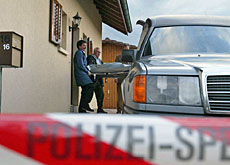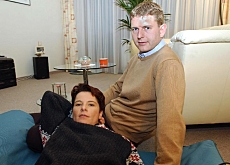Murder often takes place in the family

Almost every second murder or attempted murder is carried out within the family circle in Switzerland, according to a report released on Thursday.
On average 28 women die a year in domestic killings compared with just 13 men. Of the women, three-quarters were killed by a partner or ex-partner.
Presenting its report on murder rates in Switzerland, the Statistics Office said that between 2000 and 2004 there were around 213 victims of murder or attempted murder each year.
The report follows several family killings in Switzerland this year, including the high-profile murder of ski star Corinne Rey-Bellet, who was shot by her husband in April.
However, the authors noted that the rate in Switzerland remained low compared with other countries.
Overall men are one-and-a-half times more likely than women to be victims, but they were also seven times more likely to be suspected of committing such crimes. Most victims knew their attackers.
Forty-five per cent of murders or attempted murders were carried out within the family. The perpetrator was male in 80 per cent of these crimes, which ended fatally 54 per cent of the time.
Murderers’ favoured weapons include knives and guns, said the Federal Statistics Office.
Gun debate
The two most common weapons used in murders and attempted homicides were recorded as knives (36 per cent), followed by guns (34 per cent).
But the report found that it was knives and not guns that were most used in domestic crimes. Where guns were used it was not possible to distinguish whether these were military arms or not.
The observation comes at a time of renewed debate over the possession of guns in Switzerland. Apart from the Rey-Bellet case, several other recent family killings were committed with guns.
This led to calls from some quarters for the banning of keeping firearms in households – many men are part of Switzerland’s militia system and keep their military weapons at home. Parliament has so far baulked at tightening the law on weapons.
Caution
However, the report’s authors said that Switzerland still had a relatively low murder rate of approximately one victim per 100,000 inhabitants.
“If one is strongly interested in the issue of murders, let’s not forget that these are very rare in our country in an international comparison,” they said in their conclusions.
“However, the high proportion of crimes committed in the domestic circle shows that there is still a lot to do in prevention work.”
The report added that domestic violence cases were often linked to family problems, as well as drug and alcohol and unemployment. Many suspects were known to the police.
It went on to underline the importance of swift intervention by the authorities before a domestic conflict became fatal.
Monique Aeschbacher, from the Federal Equality Office, said in Bern on Thursday that the figures should help shape a better approach to the problem. She agreed that more prevention work was needed, and noted the success of a new law allowing violent offenders to be expelled from their homes.
For his part, the head of the Lucerne cantonal police force, Beat Hensler, said that the results would help raise awareness among police services, which are already advocating therapy and surveillance of violent offenders. But he warned that police intervention could never be a remedy for all social ills.
swissinfo with agencies
European Sourcebook of Crime (2003 figures)
Murder victims per 100,000 people:
Estonia: 10.9
Lithuania: 9.5
France: 2.0
Germany: 1.3
Switzerland: 1.0
Austria: 0.6
Mean: 2.7
70% of the victims knew their attackers beforehand; among women this rose to 85%.
Almost half – 45 per cent – of murders or attempted murders were carried out within the family. In nearly a quarter of the cases, the victim knew the perpetrator through work or another social context.
In terms of nationality, a foreigner was generally 1.8 times more likely to be a victim – or 1.7 times more in a domestic context – than a Swiss.
Foreigners were reported to be three times more likely to be suspected of these crimes than a Swiss (domestic crimes 2.7 times more).

In compliance with the JTI standards
More: SWI swissinfo.ch certified by the Journalism Trust Initiative











You can find an overview of ongoing debates with our journalists here . Please join us!
If you want to start a conversation about a topic raised in this article or want to report factual errors, email us at english@swissinfo.ch.